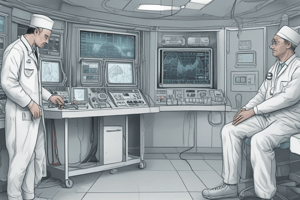Podcast
Questions and Answers
What is the primary difference between minimal sedation and moderate sedation?
What is the primary difference between minimal sedation and moderate sedation?
- Airway reflexes are unaffected in moderate sedation
- Cognitive function is impaired in moderate sedation
- Patient responds purposefully to verbal commands in moderate sedation (correct)
- Ventilatory function is impaired in moderate sedation
Which sedation level is characterized by a patient who is not easily roused but responds purposefully following repeated or painful stimulation?
Which sedation level is characterized by a patient who is not easily roused but responds purposefully following repeated or painful stimulation?
- Moderate sedation/analgesia
- Minimal sedation
- General anesthesia
- Deep sedation/analgesia (correct)
What is the primary concern in general anesthesia regarding patient ventilation?
What is the primary concern in general anesthesia regarding patient ventilation?
- Independent maintenance of ventilatory function is impaired
- Positive-pressure ventilation may be required (correct)
- Spontaneous ventilation may be inadequate
- Patient requires assistance in maintaining a patent airway
What distinguishes minimal sedation from moderate sedation in terms of patient response?
What distinguishes minimal sedation from moderate sedation in terms of patient response?
What is the primary difference between deep sedation and general anesthesia?
What is the primary difference between deep sedation and general anesthesia?
Flashcards are hidden until you start studying
Study Notes
Sedation Depths
- Minimal sedation (anxiolysis): patient responds normally to verbal stimulation
- Airway reflexes, cognitive function, and coordination may be impaired
- Ventilatory and cardiovascular functions are unaffected
Moderate Sedation / Analgesia
- Depression of consciousness is medication-induced
- Patient responds purposefully to verbal commands (alone or accompanied by light tactile stimulation)
- Airway is patent, and spontaneous ventilation is adequate
- Cardiovascular function is usually unaffected
Deep Sedation / Analgesia
- Depression of consciousness is medication-induced
- Patient is not easily roused but responds purposefully following repeated or painful stimulation
- Patient may require assistance in maintaining a patent airway
- Independent maintenance of ventilatory function may be impaired
- Spontaneous ventilation may be inadequate
- Cardiovascular function is usually maintained
General Anesthesia
- Loss of consciousness is medication-induced
- Patient is not rousable, even by painful stimulation
- Patient often requires assistance in maintaining a patent airway
- Positive-pressure ventilation may be required due to:
- Depression of spontaneous ventilation
- Drug-induced depression of neuromuscular function
- Cardiovascular function may be impaired
Studying That Suits You
Use AI to generate personalized quizzes and flashcards to suit your learning preferences.




